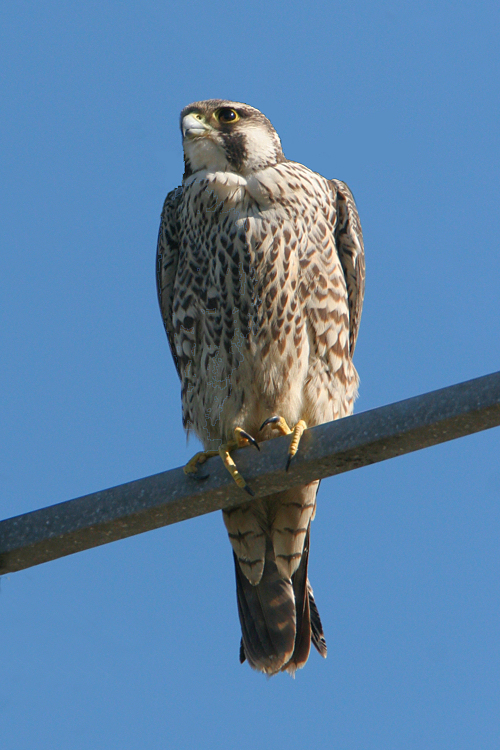
Date: 2008-02-10
Lens: Canon 600mm IS F4 + 1.4x II Converter

 Peregrine Falcon
Falco peregrinus
Peregrine Falcon
Falco peregrinus
 Description
Description
The Peregrine Falcon is on the increase after an alarming decline in the 1950s and 1960s due to eggshell thinning pesticides. One of the world's fastest birds, this falcon can reach speeds close to 320 km-h in a downward dive (called a "stoop"). Both fast and agile, these birds can catch other birds in mid-air. Their prey ranges from sparrows to ducks, which may be why this bird is sometimes referred to as the "Duck Hawk".
The falcon was worshiped in the religion of ancient Egypt as Horus, god of the sun, the great falcon whose devine eyes were the sun and moon. A sign for "god" in hieroglyphics was a falcon on a perch. Like pharaohs, falcons were sometimes mummified.
Slate-gray upperparts. Buff-white underparts, marked with fine black bars and spots. Black hood and wide black "mustaches". Short, dark, hooked beak with pale-yellow base. Underwings barred black and white. Wings are long and pointed and extend to tail tip when at rest. Yellow feet. Long, thin tail with gray and white bands. Arctic race is paler than Northwest race. Immature birds have a dark brown hood, mustaches, and upperparts. Some races have paler heads. Underparts are heavily streaked on immature. 15 to 21 inches in length.
Coasts, marshes, canyons, cities. Primarily migrates along coasts.
 Nesting
Nesting2-4 cream or buff eggs marked with reddish-brown spots. The eggs have a 29-32 day incubation period. Fledging occurs in 35-42 days. The nest is a poorly lined scrape on a cliff, building ledge, or abandoned bird's nest. Both adults help incubate the eggs. Sixty percent of the young will not survive due to their inexperience in flying and hunting.